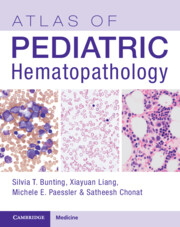Book contents
- Atlas of Pediatric Hematopathology
- Atlas of Pediatric Hematopathology
- Copyright page
- Contents
- Contributors
- Section I Peripheral Blood
- Section II Normal and Non-neoplastic Hematolymphoid Diseases
- Section III Mature Lymphoid Neoplasm
- Chapter 8 Mature B-Cell Non-Hodgkin Lymphoma
- Chapter 9 Mature T-Cell and NK-Cell Non-Hodgkin Lymphomas
- Chapter 10 Hodgkin Lymphoma
- Chapter 11 Posttransplant Lymphoproliferative Disorder
- Chapter 12 Immunodeficiency-Associated Lymphoproliferative Disorders
- Section IV Precursor Hematopoietic Neoplasms and Related Neoplasms
- Section V Histiocytic Neoplasm and Miscellaneous Bone Marrow Diseases
- Index
- References
Chapter 8 - Mature B-Cell Non-Hodgkin Lymphoma
from Section III - Mature Lymphoid Neoplasm
Published online by Cambridge University Press: 25 November 2023
- Atlas of Pediatric Hematopathology
- Atlas of Pediatric Hematopathology
- Copyright page
- Contents
- Contributors
- Section I Peripheral Blood
- Section II Normal and Non-neoplastic Hematolymphoid Diseases
- Section III Mature Lymphoid Neoplasm
- Chapter 8 Mature B-Cell Non-Hodgkin Lymphoma
- Chapter 9 Mature T-Cell and NK-Cell Non-Hodgkin Lymphomas
- Chapter 10 Hodgkin Lymphoma
- Chapter 11 Posttransplant Lymphoproliferative Disorder
- Chapter 12 Immunodeficiency-Associated Lymphoproliferative Disorders
- Section IV Precursor Hematopoietic Neoplasms and Related Neoplasms
- Section V Histiocytic Neoplasm and Miscellaneous Bone Marrow Diseases
- Index
- References
Summary
Non-Hodgkin lymphomas (NHLs) comprise about 10% of all childhood cancers [1]. They include a diverse collection of malignant neoplasms that arise from mature and immature lymphoid cells of B-cell and T-cell origin [1]. Adult and pediatric NHLs have a number of differences, including subtypes, tumor locations, and biologic behaviors, which are summarized in[1]. Morphologic evaluation of adequate tissue, immunophenotyping, and cytogenetic and molecular analysis are essential approaches in the diagnosis of NHLs. This chapter focuses on mature B-cell NHLs in children. Mature T-cell NHLs and immature lymphoid neoplasms are discussed in Chapters 9 and 13.
- Type
- Chapter
- Information
- Atlas of Pediatric Hematopathology , pp. 65 - 77Publisher: Cambridge University PressPrint publication year: 2023



